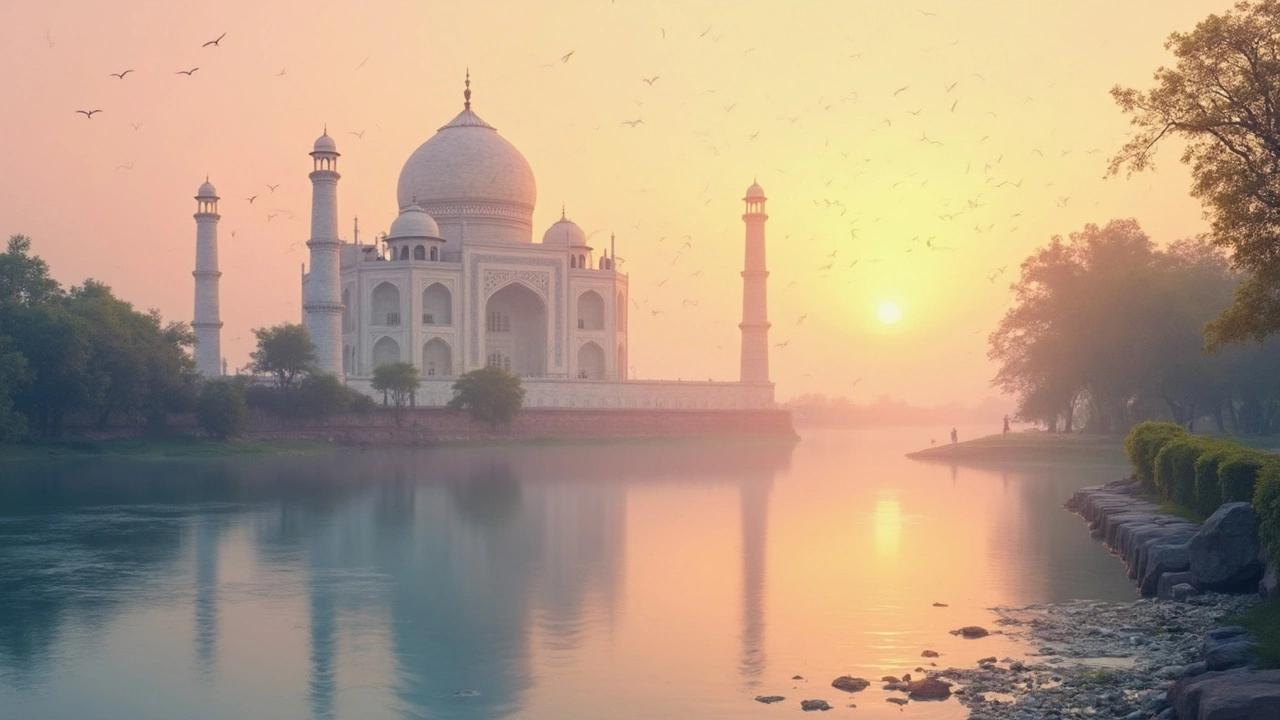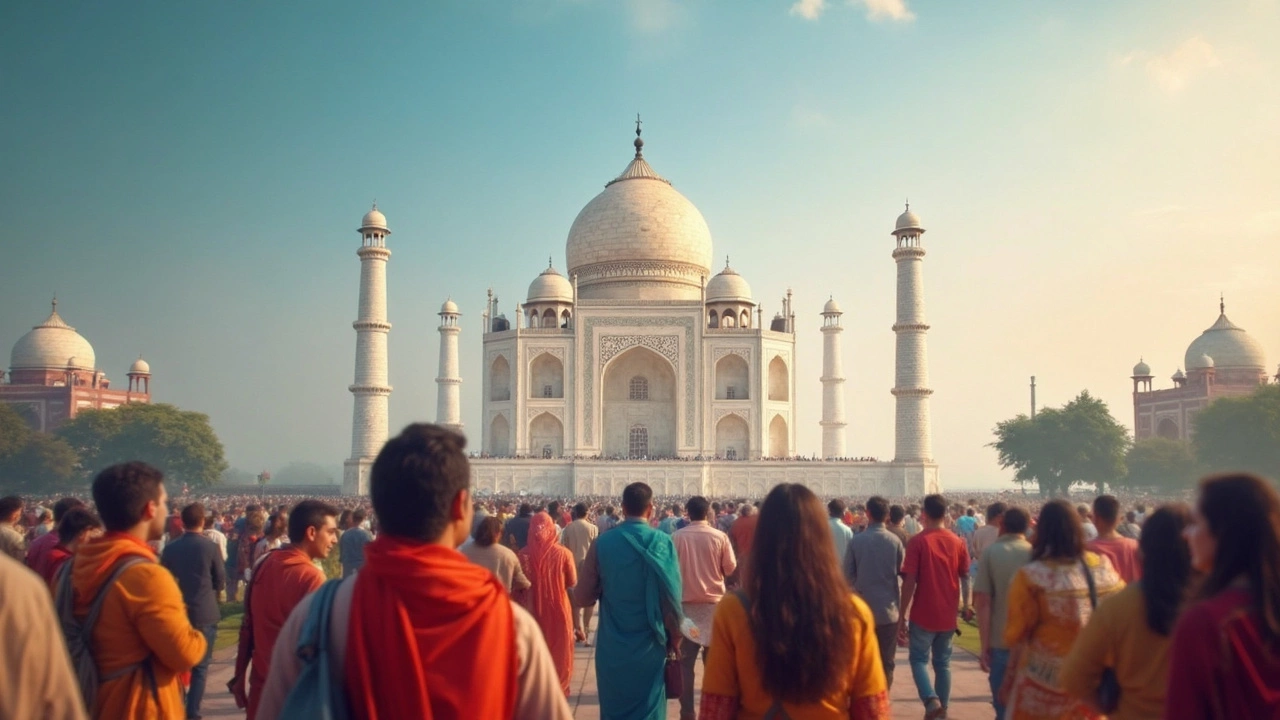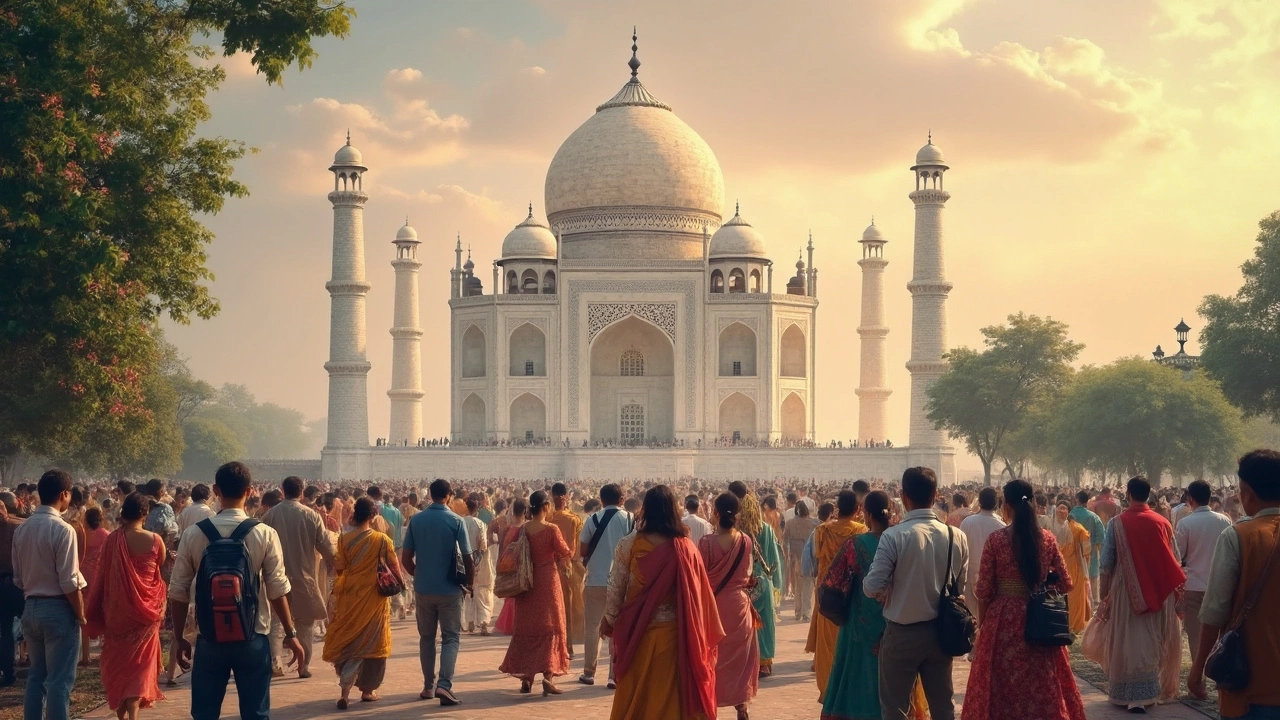Discover India's Top Tourist Gem: The Taj Mahal

When it comes to exploring India, one place consistently captures imaginations worldwide: the Taj Mahal. Nestled in Agra, this iconic mausoleum isn't just a structure; it’s a story frozen in time, a testament to love unlike any other. Built by Emperor Shah Jahan in memory of his wife Mumtaz Mahal, it's a poignant reminder of India's rich tapestry of history and culture.
What makes the Taj Mahal so magnetic? For starters, its architectural brilliance. Crafted from white marble, it reflects hues of pink, orange, and golden, depending on the light—a spectacle to witness at different times of the day. It's not just about beauty, though. The ideals of symmetry and the fusion of Persian, Islamic, and Indian architecture are mind-blowing.
If you're planning a visit, timing can make all the difference. Early mornings or full moon nights offer the best views—trust me, it's worth setting that alarm early or planning for an evening visit. Consider weekdays over weekends to skip the crowds and savor quieter moments.
- Introduction to the Taj Mahal
- Historical Significance
- Architectural Marvels
- Best Time to Visit
- Visitor Tips
- Cultural Importance
Introduction to the Taj Mahal
Let’s dive into one of the world’s most loved destinations, the Taj Mahal. Why is it so famous, and why does it pull in millions of visitors every year? Located on the banks of the Yamuna River in Agra, the Taj Mahal is much more than just a tomb; it's a symbol of undying love, architectural splendor, and historical intrigue.
Commissioned in 1632 by Mughal Emperor Shah Jahan, the Taj Mahal was completed in 1648, with additional surrounding buildings and garden finishing five years later. Legend has it that it required a workforce of over 20,000 artisans, some traveling from as far as Turkey and Persia, to finish it. Its blend of Persian, Indian, and Islamic architectural styles make it unique on the global stage.
Not only is the Taj Mahal a UNESCO World Heritage Site, but it was also declared one of the New Seven Wonders of the World in 2007. This recognition highlights its awe-inspiring design and cultural significance. Interestingly, the colors of the Taj Mahal vary, mimicking the tones of the sky from dawn till dusk.
As for architecture, it's not just the stunning marble that makes it special but its intricate embellishments. Semi-precious stones like lapis lazuli, turquoise, and jade were used for intricate inlays. The symmetrical gardens and reflecting pool add to its beauty, creating mirror-like reflections of the monument.
| Year Built | Architectural Style | Visitors Annually (est.) |
|---|---|---|
| 1632-1648 | Mughal, Persian, Indian, Islamic | Approx. 7 million |
When you hear about the Taj Mahal, it’s easy to picture a place swarming with tourists, but it’s also a serene and reflective space. Even as you marvel at its beauty, you can't escape its history—a mix of grandeur and the Emperor's heartbreak over losing his beloved wife, Mumtaz.
Historical Significance
The Taj Mahal isn't just a visual treat; it's steeped in history that dates back to the Mughal era. Commissioned in 1632 by Emperor Shah Jahan, this architectural wonder took roughly 22 years to complete, with a workforce of more than 20,000 artisans and craftsmen from across the empire.
Why all the fuss? Shah Jahan wanted to honor his beloved third wife, Mumtaz Mahal, who tragically passed away during childbirth. Her death left a void, and the emperor poured his grief into building what he envisioned as the ultimate symbol of love. The Indian, Persian, and Islamic styles merged seamlessly, showcasing the rich culture of the Mughal period.
Construction and Design
The design of the Taj Mahal is a masterstroke in symmetry and precision. The main dome, standing about 73 meters tall, is flanked by four minarets. Interestingly, these minarets were slightly tilted outward as a precautionary measure to protect the tomb during possible earthquakes—innovative engineering for the time.
The whole complex includes a mosque, a guest house, and beautiful gardens based on the Persian-style 'Charbagh' layout. This design represents paradise on earth with waterways and greenery adding to its serene atmosphere.
World Heritage Status
In 1983, the Taj Mahal earned its spot as a UNESCO World Heritage Site, recognized for its exceptional architecture and the stories contained within its walls. It stands as a narrative of a bygone era, reflecting both personal and cultural values of the time.
The monument attracts millions from all over, coming not just to see its beauty, but to feel the love story that defied the ages. It remains a significant cultural touchstone, universally acknowledged as a masterpiece of human creativity.
Architectural Marvels
The Taj Mahal isn't just a feast for the eyes—it's a testament to the genius of Mughal architecture. What’s really cool is the way it plays with light. The structure uses translucent marble panels that catch sunlight and moonlight, creating an ever-changing palette of colors. It's not unusual to see the Taj blush pink at sunrise, glow milky white under the moon, and appear golden during a sunset.
One of the standout features is its perfect symmetry. The entire layout of the site aligns exactly along an axis—everything from the gardens to the mosque and the guest house is meticulously mirrored. This precision speaks volumes about the architectural ingenuity of the time. The main dome, one of its defining elements, reaches approximately 73 meters (about 240 feet), emphasizing its grandeur.
Intricate Inlay Work
Detailing is where the Taj really shows off. The artisans used a technique called ‘pietra dura,’ decorating surfaces with inlaid stones in intricate patterns. These stones aren't your regular pebbles—they include highly prized gems like turquoise, jasper, and lapis lazuli. The sheer amount of talent and patience invested in crafting these designs is jaw-dropping.
The Gardens and Waterways
The gardens are based on the Persian style known as Charbagh. It symbolizes the four flowing rivers of Paradise, divided into four quadrants by walkways. A reflecting pool mirroring the Taj Mahal's spectacular façade adds to the serene atmosphere. Walking through the garden, you're not just appreciating nature; you're also learning about the link between architecture and spirituality in Mughal times.
Behind the Scenes: Craftsmanship and Labor
You might appreciate knowing the incredible manpower behind it. Tens of thousands of artisans, workers, and laborers worked for nearly 22 years to complete the monument. The emperor even invited specialists from different regions to ensure that each part of the Taj excelled in craftsmanship.
So, next time you gaze at the Taj Mahal, think of it not just as India’s top tourist gem but a marvel of India tourism and cultural evolution—a site where history, design, and craftsmanship converge in the most beautiful ways.

Best Time to Visit
Timing your visit to the Taj Mahal can make a significant difference in how you experience this wonder. Generally speaking, the best time to head there is either during sunrise or sunset. The early morning light brings an almost ethereal quality to the monument, and as the sun sets, the white marble reflects an array of warm hues that are simply mesmerizing.
If you’re not a fan of heat, consider visiting during the cooler months from October to March. The winter season not only offers more pleasant weather but fewer tourists, especially in early mornings, which means you can explore with a bit more elbow room. Just note that Agra can get pretty chilly in December and January, so a light sweater might be handy.
Catch the Full Moon Magic
For a surreal experience, plan to visit on a full moon night. The Taj Mahal is open for night viewing five days a month around the full moon, allowing an entirely different perspective of this majestic site under the silver glow of moonlight. Tickets for these nights sell out fast, so book well in advance if this is on your bucket list.
Weekday Visits
Weekends tend to draw larger crowds, so if your schedule allows, a weekday visit can give you a more relaxed experience. Not only will you dodge the daily swarm of visitors, but you'll also likely have more time to ponder the intricate details without feeling rushed.
Special Events
Keep an eye out for special events or festivals. Sometimes, cultural activities or performances are held nearby, providing a unique cultural flavor to your visit. Just remember to verify the event dates as they can vary each year.
All in all, whether you choose to visit during the magic of the full moon or the peacefulness of an early morning, planning your timing can turn your trip to the Taj Mahal from amazing to unforgettable.
Visitor Tips
Ready to experience the magic of the Taj Mahal? Here’s a list of practical tips to make your visit smooth and memorable.
Getting There
The Taj is located in Agra, which is easily accessible. If you're coming from Delhi, it’s about a 3-hour drive or train ride. Opt for the Gatimaan Express if you're traveling by train—it’s fast and comfortable.
Best Time to Visit
For the best experience, visit during the cooler months from October to March. You’ll avoid the intense summer heat and enjoy a more pleasant stroll around the gardens.
Entrance Details
The Taj Mahal opens at sunrise and closes at sunset, except on Fridays when it's closed for prayers. Get there early to beat the crowds and capture those stunning sunrise photos. Cultural attractions often draw lots of tourists, so the earlier, the better!
- Tickets: Buy your tickets online to skip the lines. International visitors pay around INR 1,100, while locals pay INR 50.
- Security: There’s a strict security check. Avoid carrying big bags, and note that food and other items like tripods aren’t allowed inside.
Dress Etiquette and Conduct
This is a place of reverence, so modest dress is appreciated. Light, comfortable clothing works best, and remember to carry sunglasses and a hat for the sunny walks.
Guided Tours
Consider hiring a guide. They’ll enrich your visit with fascinating stories and historical nuggets. Make sure to agree on the price upfront!
Photography Tips
The Taj Mahal is breathtaking in photos, but you’ll want to capture it without a sea of tourists. That’s another reason to get there early. Also, don’t miss the chance to shoot from Mehtab Bagh for incredible, Instagram-worthy shots across the river.
Cultural Importance
The Taj Mahal serves as more than just a photogenic structure; it’s a cultural cornerstone of India. As one of the New Seven Wonders of the World, it symbolizes not only India's historical grandeur but also the deep love narrative that resulted in its creation. Many argue that Shah Jahan’s love for Mumtaz Mahal was legendary, making the Taj an eternal testament to passion and devotion.
Being a UNESCO World Heritage Site adds to its cultural significance. This recognition underlines the Taj Mahal’s value in human history and its influence far beyond India's borders. The building's blend of architectural styles also reflects the cultural diversity in the Mughal era, highlighting intersections of art, religion, and philosophy.
Symbol of India
For locals and internationals alike, the Taj Mahal is India’s ambassador to the world, representing the country's rich past and artistic achievements. It’s a site where numerous cultural festivals and events take place, bringing Indian traditions to the forefront.
Cultural Legacy
Schools often organize trips to Agra, reinforcing how important the place is in educating future generations. It’s seen as a rite of passage for many students, reflecting the national pride in the structure. Through concerts, documentaries, and books, the Taj Mahal continues to inspire art and literature, serving as a muse for creators everywhere.
The Taj also plays a significant role in India’s tourism economy, drawing millions annually and offering locals economic opportunities through jobs in guiding, hospitality, and local crafts.
